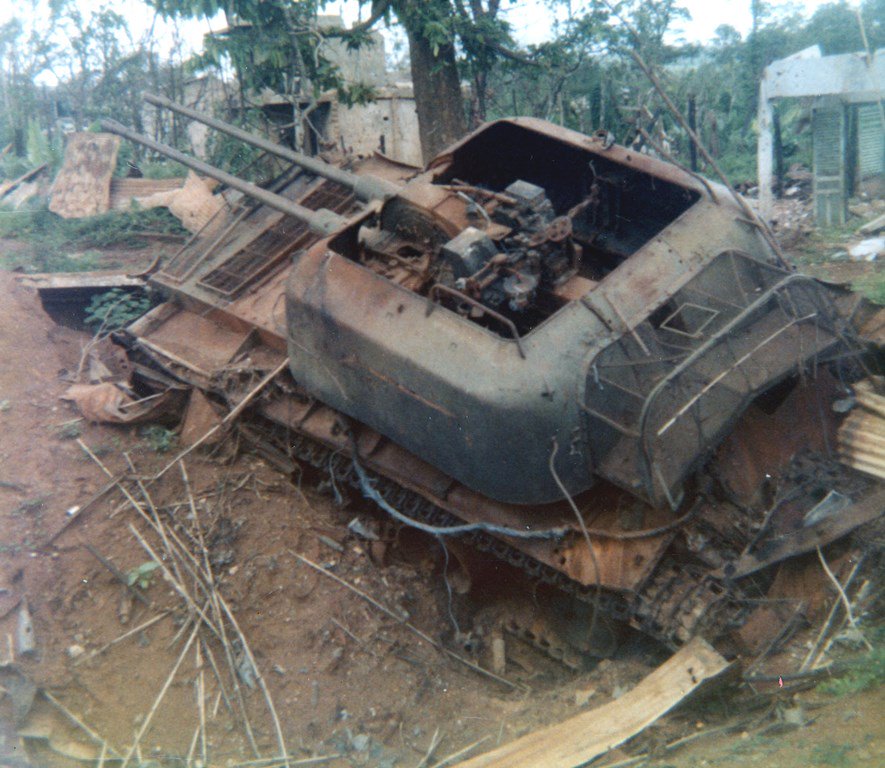Battle of An Loc
April 7, 1972

During the Easter Offensive, two armor-equipped North Vietnamese army divisions lay siege to the city of An Loc, located north of Saigon in III Corps. The assault forces the city’s South Vietnamese army defenders to engage in house-to-house fighting. They are supported by nearly continuous air support from U.S. Army, Navy, Air Force, and Marine Corps gunships, fighters, and bombers—including B-52s. The defenders hold out against enemy attacks for more than two months. The city is left largely in ruins.1
Historians disagree whether South Vietnam’s military performance during the Easter Offensive revealed that Nixon’s Vietnamization policies were succeeding. Some scholars maintain that the South Vietnamese army’s victories in major battles of the offensive, such as An Loc, against North Vietnamese conventional forces outfitted with advanced Soviet and Chinese heavy weapons indicated that South Vietnam was capable of repelling North Vietnamese attacks by 1972. These scholars emphasize that South Vietnamese soldiers fought tenaciously in the face of great odds, and that their successes raised the prestige of the Saigon government in the eyes of the South Vietnamese public. In the interpretation of these historians, the United States undermined South Vietnam’s growing defensive capabilities following the Paris Peace Accords of 1973 by withdrawing its military forces too quickly and refusing to provide air support to halt the Communist invasion of 1975.
Other historians disagree, arguing that South Vietnam could not have survived without outside military assistance. These scholars emphasize the critical and necessary role American airpower and advisers played during the Easter Offensive. They also point out that the North Vietnamese made a crucial error in 1972 by invading South Vietnam with conventional forces, a shift in strategy that transformed the conflict into one that the American-trained South Vietnamese army was more prepared to fight. During the siege of An Loc, American advisers provided expert instruction and even took command of South Vietnamese units. American air strikes decimated North Vietnamese forces around An Loc and prevented them from resupplying forces via the Ho Chi Minh Trail. Without American involvement, these scholars stress, An Loc would have fallen and the Easter Offensive would have succeeded in 1972. Instead, following the Easter Offensive’s failure, the Communists temporarily reverted to a strategy of guerrilla insurgency, the type of warfare with which American military forces had struggled, and waited for the United States to withdraw from Vietnam. Ultimately, when President Nixon removed United States military forces in 1973, North Vietnam initiated another large-scale, conventional invasion that easily overran South Vietnam in 1975.
Davidson, Philip B. Vietnam at War: The History 1946-1975. Oxford: Oxford University Press, 1988.
Hess, Gary R. Vietnam: Explaining America’s Lost War. Malden, MA: Blackwell Publishing, 2009.
Lewy, Guenter. America In Vietnam. New York: Oxford University Press, 1980.
Summers, Harry G. On Strategy: A Critical Analysis of the Vietnam War. Novato, CA: Presidio, 1982.
Sorley, Lewis. A Better war: The Unexamined Victories and Final Tragedy of America’s Last Years in Vietnam. New York: Harcourt Brace & Company, 1999.
Willbanks, James H. The Battle of An Loc. Bloomington: Indiana University Press, 2005.